The Fighters
The Fighters
We can now have a look at the armament of some WWII fighters. For
convenience, I sorted them by hitting power, in terms of fired weight per second. There is also a
chart of the evolution of fired weight per
second, which requires Java, or a plot in static gif format.
Fired weight per second is at best a rough approximation of
destructive power. It is a reasonable approximation if the destruction
is to be caused by the high-explosive or incendiary chemicals contained
in the ammunition. The amount of explosive or incendiary material is of
course related to the weight of the projectile, but it is not a linear
relationship: Rounds of smaller calibre have proportionally thicker
walls, and a smaller fraction of their weight is available for chemical
loads. Therefore the fired weight per second is usually more relevant
for larger calibre guns.
As a second measure of the destructive power, the muzzle power is given, in kilowatt. This
is the rate of production of kinetic energy. AP or "ball" rounds that
contain no chemical load only have this kinetic energy to cause damage
to the target. More is not always better; a round with a too high
kinetic energy might pass clean through the target without doing more
damage than two neat, round holes. The optimal velocity to do maximal
damage a metal plate is just below that required to penetrate it. Of
course projectiles lose a lot of the muzzle energy before they hit the
target, because of drag. In general larger calibre projectiles retain
their kinetic energy longer.
A disadvantage of AP rounds is that they cause damage in a more
limited area than incendiary or explosive rounds. Therefore
semi-armour-piercing explosive or incendiary rounds were used more
often. These require kinetic energy to penetrate the armour, and have
chemical energy to cause destruction afterwards.
A third number given is the number of
projectiles fired. If the target is not armoured, the same
weight of non-explosive projectiles does more damage when distributed
over numerous small projectiles than in a single large one, and the
number of projectiles is the most important. But if the target carries
armour the smaller projectiles are more likely to be stopped, and that
reduces the effectiveness, especially of the rifle-calibre weapons. On
the other hand, a larger number of projectiles means that the
probability of a single hit increases.
To summarize: Fired weight per second is given as an approximation of
the chemical energy that can be transferred to the target, muzzle
power as a measure of the kinetic energy, and the number of
rounds fired indicates the spreading of this transfer over a
number of hits. All three are factors that must be considered in a
consideration of the firepower installed in an aircraft. A "firepower
formula" that would allow us to actually calculate a single number as a
measure of the firepower, would be a nice thing to have. However, too
many factors are involved, and the effectiveness of ammunition
depends very much on the nature of the target.
Occasionally, firepower effectiveness was measured experimentally.
The Germans famously determined that a large sturdy bomber such as a
B-17 or B-29 could be shot down with 20 hits of 20mm ammunition, three
hits with 30mm HE ammunition, or one single 55mm hit.
Fiat C.R.42 Falco

The CR.42 is a good candidate for the best biplane fighter
ever built. But it was a contemporary of the first generation
of monoplane fighters, and completely outclassed.
[21]
- Two 12.7mm Breda-SAFAT guns, with 400 rounds per gun.
Ammunition for 34 seconds.
- They fired 23 rounds per second, corresponding to 0.86 kg.
Total muzzle power was 248 kW.
- This pathetic armament was very much the standard for the Italian
fighters of 1940. Some fighters had two 7.7mm guns added, and that
raised their firepower to 1.13 kg/sec. But because they were
underpowered they could not carry much more. The Italians finally
had to adopt German engines and German guns for their fighters.
Nakajima Ki.43 Hayabusa

A captured Ki.43 in Chinese markings. The superficial
similarity to the A6M is obvious, and caused considerable
confusion. The Ki.43 was extremely agile, but by the
standards of 1942 it was slow, undergunned and woefully
vulnerable. Nevertheless the type stayed in production
until the end of the war!
[60]
- Two 12.7mm Ho-103 guns with 250 rounds per gun, enough
ammunition for 17 seconds.
- 30 rounds per second, or 1.14 kg/sec. Total muzzle
power was 362 kW.
- The production of the Ki.43 actually began with two Type 89
7.7mm guns. This was clearly insufficient, and when production
of the Ho-103 allowed, it first replaced one and then both of
the smaller weapons. The Ki.43 was still under-gunned, and
remained so until the end of the war.
 Aircraft of the World
Aircraft of the World
Supermarine Spitfire Mk.IA

A Spitfire Mk.I with a three-bladed de Havilland airscrew. The
gun ports in the wing have been patched over with fabric,
a standard practice at the time to protect the guns from frost.
[19]
- Eight Browning .303 guns installed in the wings. 300 rounds per
gun, enough for 16 seconds of fire.
- 152 rounds per second, or 1.72 kg/sec output.
Total muzzle power 480 kW.
- The RAF was quick to understand that heavy firepower was needed,
but its initial choice was an unfortunate one. The .303 was chosen
over the .50 because of its higher rate of fire and better
reliability, but the .303 round lacked the power to penetrate
armour, and was far too light to do structural damage. Pilots
preferred to use incendiary rounds, also because they could see
them hit the target. Although some pilots had their guns
"synchronized" to converge at a point, it was more common to
have some spreading, to simplify aiming.
 Supermarine Spitfire
Supermarine Spitfire
 Supermarine Spitfire
Supermarine Spitfire
 Supermarine Spitfire
Supermarine Spitfire
Yakovlev Yak-3
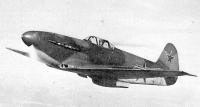
Yakovlev Yak-3. This was a highly specialized low-altitude
interceptor, with brilliant performance and handling at low
levels.
[57]
- One ShVAK cannon mounted between the cylinder banks of the engine,
with 120 rounds. One Berezin UBS in the forward fuselage decking, with
250 rounds. That was enough for 9 and 19 seconds,
respectively.
- Both guns fired 13 rounds per second, but the ShVAK cannon
put out 1.28 kg and the machinegun 0.64 kg: A total
of 1.92 kg/sec. Muzzle power was 473 kW for the ShVAK
and 230 kW for the UBS, a total of 703 kW.
- The Yakovlev fighters had a high performance at low and medium
altitude, but their small size and limited engine power restricted
their armament. The Lavochkin fighters, although also small, had
more engine power and could carry heavier armament. To some extent
these disadvantages were compensated by the excellence of the Soviet
guns, but their effectiveness was reduced by the primitive gunsights.
 Russian Aviation Museum
Russian Aviation Museum
Messerschmitt Bf 109E-3

| 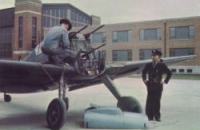
|
| Left, a Bf 109E-3.
[14]
| Right, armament installation of a Bf 109F-1, with its engine
removed. The breech of the MG 151 gun was in the cockpit, between
the feet of the pilot. The cowl guns are MG 17s.
[14]
|
- Two MG-FF cannon in the wings, with 60 rounds each; two MG 17
machineguns in the engine cowling, with 1000 rounds per gun.
The cannon ammunition was enough for 7 seconds, the machineguns
had ammunition for 55 seconds.
- Output per second was seventeen 20mm shells and 37 7.92mm
bullets. The cannon were responsible for firing a weight of
2 kg/sec. The contribution of the MG 17s was 0.37 kg/sec.
The muzzle power of the MG-FF guns was 418 kW, and that
of the MG 17 guns 114 kW; a total of 532 kW.
- The two MG 17 machineguns were too light to be very effective.
The MG-FF cannon fired effective, but low-velocity ammunition,
with a short range. Ballistic characteristics of the
MG-FF and MG 17 were too different. The Bf 109E probably was
a better bomber interceptor than the British fighters, but its
role in the battle of Britain was that of an escort fighter.
 Messerschmitt Bf 109
Messerschmitt Bf 109
 Messerschmitt Bf 109
Messerschmitt Bf 109
Mitsubishi A6M2 model 21 Reisen 'Zeke'

Mitsubishi A6M2 taking off during the Battle of Santa Cruz. The A6M2
had good performance for a carrier-based fighter and a long range,
but it was a poor basis for development.
[59]
- Two 7.7mm Type 97 machineguns in the front fuselage, with
500 rounds per gun. Two 20mm Type 99-1 cannon in the
wing, with 60 rounds per gun. The cannon had ammunition for
7 seconds, the machineguns for 30 seconds.
- The cannon fired 17 shells per second, or 2.24kg. The
machineguns fired 33 rounds in the same time, or 0.38kg.
The total was 2.62kg/sec. Muzzle power 308 kW for the
cannon, and 106 kW for the machineguns; a total of
414 kW.
- To install cannon in a fighter was an advanced concept, and
here the Japanese Navy had a lead on some other services,
notably the Japanese Army: The A6M had more than twice the
firepower of the contemporary Army fighter, the Ki.43. But
the Type 99-1 was too slow-firing, had a too low muzzle velocity,
and its ballistic characteristics did not match that of the
machineguns. There is a remarkable similarity with
the Bf 109E.
 Aircraft of the World
Aircraft of the World
 Aviation History Group
Aviation History Group
Mitsubishi A6M5b model 52B Reisen 'Zeke'
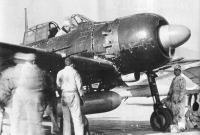
Later developments of the A6M remained inferior to their opponents.
This is an A6M5c, armed with two Type 99-2 20mm cannon
(inboard) and two 13.2mm Type 3 machineguns (outboard)
in the wings, and a third Type 3 gun in the engine
cowling.
[58]
- In the front fuselage one 7.7mm Type 97 with 500 rounds,
and one 13.2mm Type 3. Wing cannon two 20mm Type 99-2
with 125 rounds per gun. The cannon had ammunition for
15 seconds, the light machinegun for 30 seconds.
- The cannon 16 fired shells per second, or 2.11kg. The 13.2mm
machinegun fired 13 rounds in the same time, a weight of
0.69kg. The light machinegun contributed 17 rounds, or 0.19kg.
The total is 2.80 kg/sec. Muzzle power was 53 kW for the
light machinegun, 216 kW for the medium-calibre machinegun,
and 412 kW for the two cannon. Note that in comparison with
the A6M2, the weight per second fired by the cannon is down, but
the muzzle power has increased a lot.
- Upgrading the armament of the A6M gave later models a modestly
greater killing power. Much of this was because of the Type 99-2
cannon, still slow-firing but with much better ballistic
characteristics, and in its final models equipped with a belt-feed
that increased the ammunition supply. This improvement came too
late for the A6M, which was already obsolete. The last IJN fighters
of the war, such as the N1K2-J Shiden-KAI, had four Type 99-2 cannon.
 Aircraft of the World
Aircraft of the World
 Aviation History Group
Aviation History Group
North American P-51D Mustang
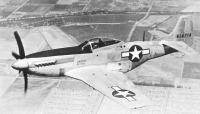
Compared with previous Mustangs, the P-51D had two more
.50 guns, and the armament installation had been redesigned
to make it more reliable.
[20]
- Six Browning .50 machine guns. The two inboard guns had 400
rounds each, enough for 32 seconds. The four outboard guns had
270 rounds, enough for 22 seconds.
- Output per second was 75 rounds, or a weight of 3.64kg per
second. Muzzle power was 1374 kW.
- Six .50 guns was the armament of most US fighters.
Most pilots liked the .50 gun, but it lacked the power to do
structural damage to enemy aircraft. Postwar research demonstrated
that only armour-piercing incendiary rounds were really effective,
by setting fire to ammunition or fuel. This armament was sufficient
for the Mustang, because it was an escort fighter, that had to
fight mostly against enemy fighters. The guns were usually set to
converge at 300 yards, and 2 degrees above the normal flight
attitude. The ammunition supply was relatively large, and that
was also beneficial for an escort fighter. Last but not least,
the Browning was very reliable and had good ballistics.
 Effects of the P-51 Mustang
Effects of the P-51 Mustang
 American Milityary Aircraft Encyclopedia
American Milityary Aircraft Encyclopedia
 Aviation History Group
Aviation History Group
 Gun Diagram at Zeno's Warbirds
Gun Diagram at Zeno's Warbirds
Yakovlev Yak-9T

Yakovlev Yak-9T. The Yakovlev family of fighters were small
aircraft, very manoeuverable and with good performance below
5000m, where most combat at the Eastern front occurred.
[56]
- One NS-37 cannon mounted between the cylinder banks of the engine,
with 32 rounds. One Berezin UBS in the forward fuselage decking, with
220 rounds. That was enough for 8 and 17 seconds,
respectively.
- The NS-37 put put out 3.06kg per second, and the machinegun 0.64kg:
A total of 3.7kg/sec. Muzzle power of the NS-37 was 1240 kW,
the machinegun contributed another 230 kW.
- Compare this with the Yak-3. The powerful 37mm cannon of the Yak-9T
had a relatively low rate of fire, but a single hit would destroy
an aircraft. The Soviets calculated that on average 31 rounds were
fired to down an aircraft, compared with 147 rounds for the 20mm
cannon. Normal firing ranges were 100m to 400m against fighters,
and 500m to 600m against bombers, but the maximum effective range
was about 1200m. On the downside, the recoil was so large that
pilots were trained to fire three-round bursts.
 Russian Aviation Museum
Russian Aviation Museum
Lockheed P-38 Lightning

The P-38 was the most successful twin-engined fighter of the war. Some
early models had one 37mm cannon, two .50s and two .30s, but production
soon standardised on one 20mm cannon and four .50s.
[32]
- One 20mm Hispano A/N-M2 cannon with 150 rounds, and four .50 Browning M2
machineguns with 500 rounds each. The cannon had ammunition for 15 seconds
of fire, the machineguns for 40 seconds.
- The cannon fired 10 rounds per second, an output of 1.3kg/sec. The
machineguns contributed 50 rounds, or 2.43kg/sec. The total is
3.73kg. The muzzle power was 503 kW for the cannon and and
918 kW for the machineguns.
- Because of its twin-engined configuration, the P-38 carried all its
armament in the nose, and no synchronisation or harmonisation were
necessary. Later
models of the P-38 were the best twin-engined fighters of the war,
the equals in combat of any single-engined fighter. Whether this
justified the additional cost and size of the P-38 is another debate.
A comparison with the P-51 shows that the 20mm Hispano was the equivalent
in weight of fire and muzzle power of two .50 Brownings; its more
deadly ammunition was another advantage. (The US Navy estimated that
the 20mm cannon was the equivalent of three .50s, reducing to 2.5 at
long range.) On the other hand the ammunition supply of the cannon
was limited.
 Planes & Pilots of WWII
Planes & Pilots of WWII
 Gun Diagram at Zeno's Warbirds
Gun Diagram at Zeno's Warbirds
 American Military Aircraft Encyclopedia
American Military Aircraft Encyclopedia
Supermarine Spitfire Mk.XIVE
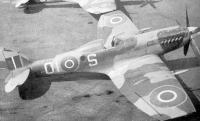
A late-production Spitfire FR Mk.XIVE. Note the modified nose
contours for the Griffon engine, five-bladed propeller, bubble
cockpit and camera port in the aft fuselage.
[18]
- Two Hispano cannon in the wing, with 120 rounds each. Two
Browning .50 guns, with 250 rounds each. The cannon ammunition
lasted for 12 seconds; the machinegun ammunition for 20
seconds.
- The two cannon fired 20 rounds per second, the two machineguns
25. Total output was 3.81kg per second. Muzzle power was
1006 kW for the two cannon, and 458 kW for the two
machineguns. Total 1464 kW.
- Because the original armament of eight Brownings was too
weak, later Spitfires had the "C" or "universal" wing which
allowed the installation of eight .303 guns, two 20mm cannon
and four .303 machineguns, or four 20mm cannon. But the late
production Mk.IX and the Mk.XIV had the "E" wing, with the
definitive wartime armament for the Spitfire: Two 20mm cannon
and two .50 guns. The Spitfire was a small fighter, and its
thin wing complicated armament installations. But the E-wing
armament was very effective. An important factor was the use
of gyroscopic gunsights by the Allies, because they greatly
improved accuracy. The Germans developed similar gunsights, but
they were never reliable enough to be useful.
 Supermarine Spitfire
Supermarine Spitfire
 Supermarine Spitfire
Supermarine Spitfire
 Aviation History Group
Aviation History Group
Kawasaki Ki.61-I-KAI-Hei Hien 'Tony'
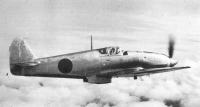
The Nakajima Ki.61 Hien, or Army Type 3 Fighter, Allied
codename Tony, was at first believed to be a copy
of a German or Italian design. In fact only its Ha-40
engine was a licensed version of the Daimler-Benz DB 601.
[17]
- Two 20mm Ho-5 guns with 120 rounds per gun, and two 12.7mm Ho-103
guns with 200 rounds. The machineguns had ammunition for 13 seconds
and the cannon for 9 seconds.
- The cannon put out 28 rounds per second, or 2.81kg/sec. The
machineguns contributed 30 rounds, or 1.14kg. Total 3.95 g/sec.
Muzzle power was 944 kW for the cannon, and 362 kW
for the machineguns; a total of 1306 kW.
- The Ki.61 was the first fighter of the Imperial Japanese Army
that was the equal of or better than the Western designs it
encountered. The best Japanese Army fighter of the war, the Ki.84,
initially carried the same guns, although with more ammunition.
Later versions of the Ki.84 had four Ho-5 cannon, or even
two Ho-5 and two Ho-155 cannon. This marked a switch by the Army
from lightly-built, lightly-armed dogfighters such as the Ki.43, to
sturdy, heavily armed all-round fighters.
 Aircraft of the World
Aircraft of the World
 Mark's Japanese Aviation
Mark's Japanese Aviation
Republic P-47D Thunderbolt

With eight .50s, the P-47 carried the heaviest armament of the
US single-seat fighters.
[31]
- Eight Browning .50 machine guns. Up to 400 rounds could be carried,
enough for 32 seconds of fire, but the ammunition load was often
reduced to compensate for the carriage of bombs or external fuel
tanks.
- Output per second was 100 rounds, or a weight of 4.85kg per
second. Muzzle power was 1835 kW.
- The Thunderbolt was designed around the R-2800 radial and
its turbosupercharger. It was one of the largest fighters of
its time, and also one of the most rugged. It carried eight
.50 guns in the wings, with ammunition storage in the outer
wing panels. The P-47 had a successful career as fighter-bomber
after the P-51 replaced it as escort fighter.
 American Military Aircraft Encyclopedia
American Military Aircraft Encyclopedia
 Gun Diagram at Zeno's Warbirds
Gun Diagram at Zeno's Warbirds
Focke-Wulf Ta 152H-1
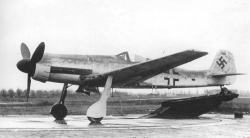
Above, a Ta 152H-1. Note the slender long-span wings of this
development of the Fw 190, and the Jumo 213 V-12 engine with
annular radiator.
[11]
- One MK 108 cannon firing through the propeller spinner, and
two MG 151/20 cannon in the wing roots. The 30mm cannon had 90
rounds, the 20mm cannon had 175 rounds each. This was ammunition
for respectively 9 and 14 seconds of fire.
- Per second, ten 30mm shells and 25 20mm shells were fired. This
amounted to a weight of 5.96kg.
The muzzle power of the MK 108 was a modest 398 kW, and the
20mm cannon contributed 720 kW. Total 1118 kW.
- This high-altitude interceptor was armed to fire a short, heavy
burst at its target. The MK 108 cannon was a low-velocity weapon,
designed to inflict fatal structural damage to the heavy bombers
of the 8th AF.
 Aircraft of the World
Aircraft of the World
Hawker Tempest Mk.V

Hawker Tempest Mk.V. This one is armed with Hispano Mk.V cannon.
Early Tempests had Mk.II cannon, and the longer barrels extended
in front of the wing leading edge.
[63]
- Four Hispano Mk.V cannon, installed within the wing, with 200 rounds
per gun. That was ammunition for 16 seconds.
- Per second 50 rounds were fired, with a total weight of 6.5 kg.
Total muzzle energy was 2292 kW.
- This was the definitive armament option for British WWII
fighters, although a number of designs and prototypes featured
six Hispano cannon. It was also retained by the first generation
of jet fighters, becoming a de facto standard in the first
year after the war. The exceptions were the USAAF, that continued
to rely on the .50, and the USSR, that prefered 23mm and 37mm
cannon.
Messerschmitt Me 262A-1a

A Messerschmitt Me 262, photographed in April 1945 in
Switzerland.[55] Allied
observers at first criticised the choice of four 30mm cannon,
estimating that the rate of fire could scarcely exceed five
per second.[64] But the
MK 108 fired two times faster than that.
- Four MK 108 cannon in the nose. Two had 80 rounds, two had
100 rounds, for respectively eight and ten seconds of fire.
- Forty 30mm shells per second, or 12.5kg per second. Muzzle
power 1592 kW.
- The armament of the Me 262 was deadly against heavy bombers.
The ammunition for the MK 108 cannon was of the "Minengeschoss"
type, thin-walled high-explosive shells. Because of the low
muzzle velocity of the MK 108, it was not very suitable for
fighter-vs-fighter combat, but in principle the Me 262 could
outrun any enemy. In practice the Me 262 were always heavily
outnumbered by the escort fighters, and their success was
quite limited.
 Stormbirds
Stormbirds
 Me 262 Net
Me 262 Net
| Name | Rounds | Weight | Energy |
| | (1/sec) | (kg/sec) | (kW) |
| Fiat CR.42 Falco | 23 | 0.86 | 248 |
| Nakajima Ki.43 Hayabusa | 30 | 1.14 | 362 |
| Supermarine Spitfire Mk.IA | 152 | 1.72 | 480 |
| Yakovlev Yak-3 | 26 | 1.92 | 703 |
| Messerschmitt Bf 109E-3 | 54 | 2.37 | 532 |
| Mitsubishi A6M2 Reisen | 50 | 2.62 | 414 |
| Mitsubishi A6M5b Reisen | 46 | 2.80 | 681 |
| North American P-51D Mustang | 75 | 3.64 | 1374 |
| Yakovlev Yak-9T | 17 | 3.70 | 1470 |
| Lockheed P-38J Lightning | 60 | 3.73 | 1421 |
| Supermarine Spitfire Mk.XIVE | 45 | 3.81 | 1464 |
| Kawasaki Ki.61-I-KAI-Hei Hien | 58 | 3.95 | 1306 |
| Republic P-47 Thunderbolt | 100 | 4.85 | 1835 |
| Focke-Wulf Ta 152H-1 | 35 | 5.96 | 1118 |
| Hawker Tempest Mk.V | 50 | 6.50 | 2292 |
| Messerschmitt Me 262A-1a | 40 | 12.50 | 1592 |
A longer list of fighter armaments is reproduced elsewhere. It is clear from this table that
muzzle energy and weight of fire are related, because a heavier weight
of fire usually means a proportionally higher muzzle energy. This simply
reflects the fact that the muzzle velocities of the guns used are
typically around 825 m/sec, so that the kinetic energy per unit of
projectile weight is approximately 340 kJ/kg.
The exceptions are the MG-FF, Type 99-1 and MK 108. These are all
low-velocity weapons, and fighters equipped with these weapons have a
lower total muzzle power, although the weight of fire might be quite
high. The best example is of course the Me 262.
There is no obvious relationship of either weight of fire or muzzle
power with the total number of rounds fired per second. This value also
does not show any clear trend towards either an increase or a decrease,
although there are a few exceptionally low or high values.
Next: Analysis
© 1998-1999
Emmanuel Gustin
gustin@uia.ua.ac.be
 visitors since 23 December 1998.
visitors since 23 December 1998.

















visitors since 23 December 1998.